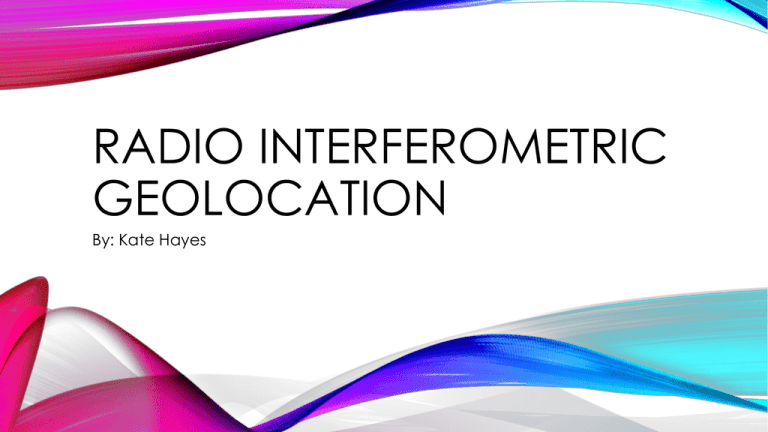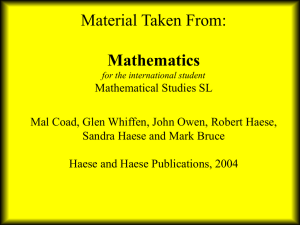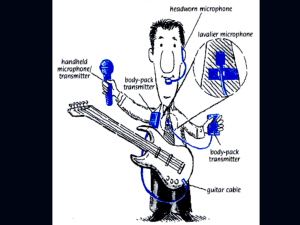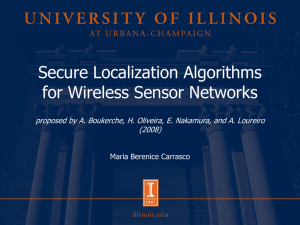Radio Interferometric Geolocation
advertisement

RADIO INTERFEROMETRIC GEOLOCATION By: Kate Hayes OUTLINE • Introduction • Theoretical background behind radio interferometry • Analyzing sources of error • Prototype implementation • Technique discussion for distance • Localization algorithm • Field Experiments • Conclusion http://thor.he.net/~gludlow/rip.gif INTRODUCTION TO STATE OF THE ART • Acoustic WSNs have limited range of high accuracy • Acoustic WSNs need special actuator/detector pairs which adds to the cost • A number of applications require privacy making the very limited Ultrasound signal the only option • Most WSNs are only available in 2D • There seems to be the ability to have adequate accuracy or acceptable range but not both simultaneously http://1.bp.blogspot.com/PVllJa9oZQ4/TsqXGQT3v4I/AAAAAAAAABk/bX86RnnG a-4/s1600/sensor_network_big.gif RADIO INTERFEROMETRY • Radio interferometry is traditionally used in physics, geodesy, and astronomy http://fas.org/irp/imint/docs/rst/Intro/vlbi_concept.jpg • The method uses two or more directional antennae to measure the radio signal from a single source and performing cross-correlation • A radio interferometer is very expensive requires tunable, directional antennae; high sampling rates; and high precision time synchronization • This device is not directly applicable to WSNs http://perg.phys.ksu.edu/vqm/laserweb/ch-10/10-1.gif RADIO INTERFEROMETRIC POSITIONING SYSTEM (RIPS) • Radio Interferometric Positioning System (RIPS) is the novel idea to use the concepts behind interferometry and apply them to WSNs • The main idea is to use two nodes as transmitters that create the interference pattern which is measured by two receivers • The frequencies emitted by the transmitters are almost the same, which when combined create a low frequency envelope • The two receivers measure the wave packet’s phase difference and use this to determine the relative position of the four nodes • The key attribute is that the phase offset of a low frequency signal is measured and it corresponds to the wavelengths of a high-frequency carrier signal PHASE OFFSET http://hyperphysics.phyastr.gsu.edu/hbase/sound/imgsou/beat4.gif http://medias.audiofanzine.com/images/thumbs3/642 391.jpg • The composite (addition of the two transmitters signals) signal has a low beat frequency • Relative phase offset is measured rather than the phase offset so that timing synchronization can be avoided • Relative phase offset between two receivers depends on only on the four distances between the receivers and transmitters and the wavelength of the carrier frequency • By measuring different carrier frequencies it is possible to calculate linear combinations of the distances between nodes and infer position THEOREMS OF THE RIPS METHODS THEOREM 1 • The RSSI signal is the power of the incoming radio signal measured in dBm after it is mixed down to an intermediate frequency fIF • It is then low pass filtered with filter cutoff frequency fcut, where fcut << fIF • Let r(t) denote this filtered signal • Theorem 1: Let f2 < f1 be two close carrier frequencies with δ = (f1 − f2)/2, δ << f2, and 2δ < fcut. Furthermore, assume that a node receives the radio signal s(t) = a1 cos(2πf1t + φ 1) + a2 cos(2 π f2t + φ 2) + n(t), where n(t) is Gaussian noise. Then the filtered RSSI signal r(t) is periodic with fundamental frequency f1 − f2 and absolute phase offset φ1 − φ 2 THEOREMS OF THE RIPS METHODS THEOREM 2 • Theorem 2: Assume that two nodes A and B transmit pure sine waves at two close frequencies f > f such that f − f < f , and two other nodes C and D measure the filtered RSSI signal. Then the relative phase offset of r (t) and r (t) is A C B A B cut D 2π[(2d − d ) / (c/f ) + (d − d ) / (c/f )] AD AC A BC BD B (mod 2π). THEOREMS OF THE RIPS METHODS THEOREM 3 • Theorem 3: Assume that two nodes A and B transmit pure sine waves at two close frequencies f > f , and two other nodes C and D measure the filtered RSSI signal. If f −f < 2 kHz, and d , d , d , d 1 km, then the relative phase offset of r (t) and r (t) is A A C 2π[(d − d + d − d )/(c/f)] AD BD BC AC where f = (f + f )/2 A B •d =d −d +d −d ABCD AD BD BC AC B B AC D (mod 2π) AD BC BD THEOREMS OF THE RIPS METHODS THEOREM 4 • Theorem 4: In a network of n nodes there are at most [(3/2)*(n−2)(n−3)] independent interference measurements that can be made • The solution to the system of equations is invariant under translation, rotation, and reflection • The number of unknowns is (2n - 3) in a 2D network and (3n – 6) in 3D • At least 8 nodes in 3D are needed to get more measurements (20) than the number of unknowns (18) SOURCES OF ERROR (1) • Carrier Frequency Inaccuracy – The difference between the nominal and actual carrier frequency of the transmitted signal. • Carrier Frequency Drift and Noise – The phase noise and drift of the actual carrier frequency of the transmitted signal during the measurement. Any noise of drift will be directly observable. This error can be minimized by shortening the length of a single phase measurement http://thumb1.shutterstock.com/displ ay_pic_with_logo/450076/450076,1284 955408,4/stock-photo-error-icon61313860.jpg • Multipath Effects – Anytime the RF signal bounces off anything rather than traveling directly to the receiver. It is expected higher level algorithms can filter this error out SOURCES OF ERROR (2) • Antennae Orientation – Time of Flight can change if the antennae are not pointed directly at the receivers • RSSI Measurement Delay Jitter – The jitter of the delay between the antennae receiving the radio signal and the RF chip delivering the RSSI signal to the signal processing unit • RSSI Signal-to-Noise Ratio – The signal strength relative to the noise of the rC(t) signal. SNR mainly depends on the distance between transmitters and receivers as the amplitudes of the signal decrease exponentially in space • Signal Processing Error – Error introduced by the signal processing algorithm that calculates the phase offset • Time synchronization Error – Error of the time instance when the receivers measure their absolute phase offset of the received signal strength IMPLEMENTATION • Selecting a pair of transmitters from a group of motes participating in the localization and scheduling their transmission time • Fine-grain calibration of the radios of senders to transmit at close frequencies • Transmission of a pure sine wave by the two senders at multiple frequencies • Analysis of the RSSI samples of the interference signal at each of the receivers to estimate the frequency and phase offset of the signal • Calculation of the actual dABCD range from the measured relative phase offsets for each pair of receivers • The Localization Algorithm • Selection and scheduling of transmitting pairs, distance calculations, freq. calibration, and localization are all done on the base station PHYSICAL ATTRIBUTES • Uses the MICA2 mote platform with TinyOS operating System • Chipcon CC1000 radio • Allows pure sine wave transmission at a specific frequency • Radio engine component that coordinates and synchs the particular nodes and handles the interference signal • A signal processing component estimates the phase and freq. of the sample signal • Transmits at different power levels and a wide freq. band • Time required to calibrate has a large 5 ms jitter http://deliveryimages.acm.org/10.114 5/1000000/990705/figs/f2.jpg TIME SYNCHRONIZATION • Measuring the relative phase offset of the interference signal at the receivers requires measuring the absolute phase offset relative to a common time instant • After getting the absolute phase offsets from each node the relative phase offset is achieved by subtracting them from each other • Only the 4 nodes participating are time synched and only for the duration of the synching • The master node sends out a packet with a precise timestamp to all participating nodes who then use that timestamp to calibrate to their local time • This message specifies when the calibration or tuning will take place in the future and at what powers to do them at TUNING • The CC1000 chip needs to perform internal calibration of the internal frequency synthesizer PLL (phase locked loop) • Calibration is required to compensate for supply voltage and temperature variations • Channel 0 is at 430 MHz and each channel is a .526 MHz step up • PLL on C1000 chip can get up to 65 Hz freq. resolution • Due to time and sampling rate constraints the difference between the broadcast frequencies is from 200 – 100 Hz • Freq. tuning algorithm determines settings for transmitters of the same frequency • f = 430.1 + 0.526 · channel + 65 · 10−6 · tuning. PEAK DETECTION AND FILTERING • Samples are processed on nodes • Signal Processing Algorithm estimates the frequency and phase of RSSI signal • Some of the data is processed online, but it is limited and more extensive data is processed later post-processing FREQUENCY AND PHASE ESTIMATION • Raw samples are filtered in a way to enhance SNR • Max and Min peaks are acquired from the leading 24 samples for the adaptive peak detection algorithm • The acquired amplitude serves as quality indicator • Peaks are discarded if they do not cross the low threshold in order to get rid of false positives • Post-processing works on peak indexes and determines the period and freq. is the reciprocal of the period • Phase is estimated by the average phase of the filtered peaks SCHEDULING High-Level Low-Level • Responsible for selecting the pair of transmitters • Coordinates the activities of the two transmitters and multiple receivers • Minimizes the number of interference measurements while still allowing enough to acquire a 3D localization • Frequency tuning algorithm and phase offset estimation require proper freq. calibration and timing • Base selects all possible pairs of transmitters while all nodes within range act as receivers • Has different transmitters use different powers to account for differing distance from the receivers RANGE CALCULATION • dABCD = λini + γi = λjnj + γj , • A set of wavelengths is needed so that their least common multiple is larger than the domain of the distance • The equations become invalid due to noise and are reduced to similar inequalities • Solving for the inequalities gives the average di value • The answer with minimum value to its error function becomes the final estimate LOCALIZATION • RIPS does NOT provide ranging between nodes but rather a combination of distances between the 4 nodes • Remember dABCD = dAD − dBD + dBC − dAC • A Genetic Algorithm (GA) is used to determine the relative position of the nodes • The algorithm uses all the given ranges and tries to minimize the difference between the input range and the range in the solution • The solution with the least amount of error is selected http://upload.wikimedia.org/wikipedi a/commons/f/ff/St_5-xbandantenna.jpg EFFECTIVE RANGE • Determining range is not straightforward because it is not direct pairwise • The maximum distance between a transmitter and receiver is the related to the radio range • The interference signal can be “heard” almost twice as far away as the radio range this is called the Interferometric Radio Range (IRR) (r) • No constraint on distance between two transmitters or receivers, however they need to be in twice the IRR • Signals need to be tuned so one signal is not much stronger than the other transmitter’s • Possible values of the distance : − 2r < dABCD < 2r. EXPERIMENTAL SETUP • 16 nodes in a 4x4 grid • 3 anchor points randomly chosen • 18x18 meters • This is only testing 2D • Testing on flat grassy field FREQUENCY ACCURACY • Results comparable to high resolution discrete Fourier transforms were achieved • One of the senders changed its carrier freq. in small increments • Ideal V-shaped curve appears matching tuning parameters • Phase difference (bottom) have more noise as expected PHASE ACCURACY • One pair of motes were fixed as transmitters • Frequency tuning around 0 Hz interference • Repeated 30 times • Median phase and average deviation at each frequency • Calculated average of the deviations • Used amplitude as a quality of measurement indicator RANGING ACCURACY • The error distribution of the calculated dABCD ranges can be approximated by the superposition of a set of Gaussian distributions • Filtering is used to improve the number of 0 error peaks while keeping enough information to use • Amplitude of the signal shows strong correlation with error in ranging • Interference signal is measured by all modes in range • Bad frequency measurements lead to bad range measurements and are filtered out LOCALIZATION ACCURACY • Localization was run using the filtered data • Genetic optimization was run for 2 minutes with the results in the above right figure • Average accuracy was 5 cm • Largest error was under 10 cm • RIPS is pretty accurate in 2D LATENCY • Because so many measurements are required to take place between different arrangements, different algorithms, freq. tuning, and actual measurements the process takes about 80 minutes • The tuning algorithm, range calculations, and localization are done on the base station • Using less combinations would drastically reduce the time to get results without sacrificing accuracy • If the tuning algorithm is implemented on the motes the time can also be cut down by shortening message routes • Its possible to decrease the number of tuning steps required as well • The network is easily scalable since each section can be divided up by radio range CONCLUSION • RIPS achieves high accuracy and long range simultaneously • Supports 3D localization • Does not require extra hardware or calibration • Two transmitters create an interference signal whose phase offset is measured by receivers • This phase offset can be used to determine the range related to all 4 nodes involved in the measurement • From all the relative measurements the map of the 3D network can be determined RF ANGLE OF ARRIVALBASED NODE LOCATION OUTLINE • Introduction • Technique • Analysis of Technique • Implementation • Experimental Results • Conclusion http://images.tutorvista.com/cms/im ages/102/hyperbola.png INTRODUCTION • In comparison to other localization methods which use large infrastructure, extensive processing, and/or long latencies TRIPLOC is a rapid localization distribution method that uses radio interferometry like RIPS but improves upon it • TRIPLOC gathers it’s four nodes into a group of three orthogonal nodes and one or more receiver farther away • On the anchor antennae array two of the nodes are transmitters and one is a receiver • The measured phase difference between the receiver on the TRIPLOC array and the other receiver constrains the location of the latter to the hyperbola SOME TERMINOLOGY • Node position is usually determined by ranging or bearing • Ranging- node estimates its difference to different reference points • Bearing- the angle between forward facing direction and direction to object • Triangulation is the process of determining the position of an object from the bearings of known reference points • TRIPLOC employs Bearing from multiple nodes to determine location https://engineering.purdue.edu/~as m215/topics/brngdir.gif http://upload.wikimedia.org/wikipedi a/commons/5/54/Slant_range.png RADIO INTERFEROMETRY (RI) http://chezsez.files.wordpress.com/2010/06/ 600px-doppler_effect_svg.png • Bearing estimates are useful when anchor positions are known • Several acoustic beamforming techniques have been proposed to find the angle of incidence if a signal at an array of sensors • There have been several improvements on the RIPS system to track mobile devices and improve latency • Mobile nodes have their RF signals undergo a Doppler shift • From the Doppler shift the motion and position can be determined • TRIPLOC cannot do localization for mobile nodes, but it performs the calculations so fast that it can do it for slowly moving nodes RI MEASUREMENTS • TRIPLOC array midpoint is assumed known as well as distance between antennae • At predetermined time P and A_1 transmit a pure sinusoidal signal at slightly different frequencies • A_2 and the receiver node (R) measure the low-frequency beat interference pattern created by P and A_1 • This is termed a Radio Interferometric Measurement (RIM) • The maximum distance difference will occur when the receiver node is collinear with the transmitters this removes the 2pi modulo ambiguity • dA_1PR =ДΦλ/2π BEARING APPROXIMATION 1 • dA_1PR defines the arm of the hyperbola that intersects the position of node R and whose asymptote passes through the midpoint of the line A_1 and P • The distance between the hyperbola center and the intersection point H is defined as a • The length of the line segment perpendicular to the axis containing the foci that extends from the H to the asymptote is called b • In order to solve for β the values of a and b must be determined 𝑑𝐴_1𝑃𝑅 • β = 𝑐𝑜𝑠 −1 ( 𝑑𝐴_1𝑃 ) BEARING APPROXIMATION 2 • β could be +/- because if the symmetry of the hyperbola • In essence each RIM gives two possible β measurements • To solve for this the assistant nodes switch roles and perform a second RIM • Due to the fact that the center of the hyperbolas are not the same for each RIM there is an allowed error threshold • The average of the two βs that have error under the error threshold is the bearing estimate βhat • R must be farther away from the node because the error in beta will be larger if it is close due to the hyperbolic shape TRIANGULATION • When the approximate bearing of R is determined (β) its position can be determine using triangulation • Using two known angles and a known side the distance to R from either anchor node can be determined • If R is ambiguous then three have to be used, but if a β is slightly off then there will be error • The triangulation technique used was Least Squares Orthogonal Error Vector Solutions which basically uses linear algebra to come up with Rhat the position estimate with noising bearing measurements BEARING ESTIMATION ERROR • Because computing distance differences can be computationally intensive several assumptions are made by the TRIPLOC system • Measurements noise • Asymptotic approximation • Translation of bearing candidates • The analysis of array position and orientation errors are purposefully omitted • These assumptions are made instead • The antenna configurations are known • Transmitter location is known • Relative bearings are known MEASUREMENT NOISE ERROR • Distance Differences can contain error in the form of measurement error • This error can come from non-ideal signal propagation, noise from circuitry, sampling error, or other sources • Estimating the amount of error in βhat is done by taking the partial derivative with respect to distance • To see what amplification effect an error in a given distance difference d produces on the bearing estimate, evaluate the partial derivative at d • When the absolute value of the measured distance difference is close to the antenna separation, the computed bearing candidates are very sensitive to measurement noise ASYMPTOTE APPROXIMATION • For a pair of transmitters the bearing of the receiver is approximated with angles of the asymptote of the receiver • It is assumed that the receiver lies on the hyperbolic asymptote, rather than on the hyperbola itself • For close receivers errors of this type are not negligible • This error is βhat minus β and is given the symbol ε • The error of the approximation decreases as the distance of the receiver from the transmitter array increases TRANSLATION OF BEARING CANDIDATES • At least two transmitter anchors are needed because for each transmitter pair there are two possible βs • Bearing candidates are treated as vectors from the center of the hyperbola • These vectors need their coordinates translated from the hyperbolic to the system coordinates • A vector translated this way will not point directly at the bearing anymore but slightly off • If the receiver is far enough away it won’t be off enough to matter COMPOUND BEARING ESTIMATION ERROR • Two transmitter pairs each report two bearing candidates for a total of four bearing estimates • Its likely only two should be close to each other (The correct ones) • In order to figure out which ones they are all possible pairs of one from each transmitter are taken • The pair with the least pairwise angular distance is selected and the average is taken to give βhat • In the diagram over 500 simulations are run with an added Gaussian noise • Errors peak where expected where the individual transmitter pairs exhibit high error sensitivity POSITION ESTIMATION ERROR ANALYSIS • Triangulation is used to compute the distance to the receiver from the bearing measurement • Simulation results are presented to demonstrate the effect of error from different sources and reference real experiments • Position error comes from three different sources: • Position of the arrays • Orientation of the arrays • Bearing estimation error POSITION ERROR OF THE ARRAYS • T_2 is varied along the x axis and error is calculated for whether the measurement of T_2 was off by .1, .2, or .3 m ORIENTATION ERROR OF THE ARRAYS • To simulate orientation error a constant was added to the bearing reported from T_2 • As expected R between the two Ts gives a large error estimate BEARING ESTIMATION ERROR • Assume location and orientation of the two antenna arrays are known • Assume that the bearing estimates have added white noise in form of a Gaussian random variable with σ being changed for each run • Results suggest that as standard deviation of the bearing error is increased the standard deviation of the location area increases as well TRIPLOC SYSTEM SPECS • Crossbow ExScal motes • TI CC1000 radio chip • Mutually orthogonal antennae to reduce parasitic effects (35.35 cm apart) and with a wavelength greater than 70.7 cm to avoid 2pi modulo • TinyOS operating system • All operations run locally • Initialization of localization process is required first • Create and broadcast a schedule of when array anchors perform the RIMs • All anchors keep track of when each anchor is performing the RIM so they know when it is their turn • Tuning is required. Two broadcast in increments and one monitors until it finds the matching beat frequency lets the others know • Calibration of the bearing system is requires. To calibrate place receivers at known locations and run the estimation algorithm, the difference is the true orientation of the arrays MAKING RADIO INTERFEROMETRIC MEASUREMENTS • Because phase difference is used to calculate the bearing the signal must be measured at the same instant • TRIPLOC uses the same method as RIPS to synchronize clocks with a primary node sending out a message with the time of its system in the message, a receiver measures the time it received this message and calibrates the two times • After synchronization the radio needs to be acquired from the MAC layer • Next the radio is calibrated • Transmit and sample enough RSSI periods (about 6) to get a phase difference • Restore the radio to its original state so information can be shared by the nodes LATENCY ANALYSIS • Latency is the amount of time it takes from making the measurement to getting the result, in this case the position of the receivers • Since TRIPLOC is intended for mobile arrays it must perform very fast RIMs so the sensor hasn’t had time to move far • Each array performs two RIMs, one for each P,A pair • The bottom line is TRIPLOC allows its receivers to calculate their position in less than 1 s EXPERIMENT 1 • Experiment 1 measures the bearing accuracy of six receiver nodes • The nodes are placed 60 degrees apart 10 m from the center anchor node A • Performed 50 bearing estimates • This experiment is consistent with the error predictions for bearing estimations EXPERIMENT 2 • Experiment 2 was measuring the accuracy of 14 receiver nodes from three arrays • Outdoor, low-multipath environment • More real world than other experiments • 35 bearing estimates from each anchor to all nodes so 1470 estimates total • This experiment is also consistent with expected results from the bearing error estimate analysis EXPERIMENT 3 • 20x20 m with 4 anchors in the corners and 16 nodes in a slightly randomized grid • Each target node (one in grid) periodically estimates its position using the bearing estimation and triangulation techniques presented in the paper • 100 estimations for each target • Average overall position error was found to be .78 m CONCLUSION • TRIPLOC is a method for rapidly distributed bearing estimation and localization • The array anchor consists of three nodes arranged orthogonally to each other • Two transmit slightly different frequencies and one measures the phase difference of the beat frequency with another receiver a distance away • The phase distance defines a hyperbola from which bearings can be estimated • From these bearing estimations localization can be calculated • Average bearing accuracy is 3.2 deg. and avg. position accuracy is .78 m • All processing is done on nodes and avoids the 2pi modulo ambiguity • TRIPLOC has a very fast localization time of about 1 second





